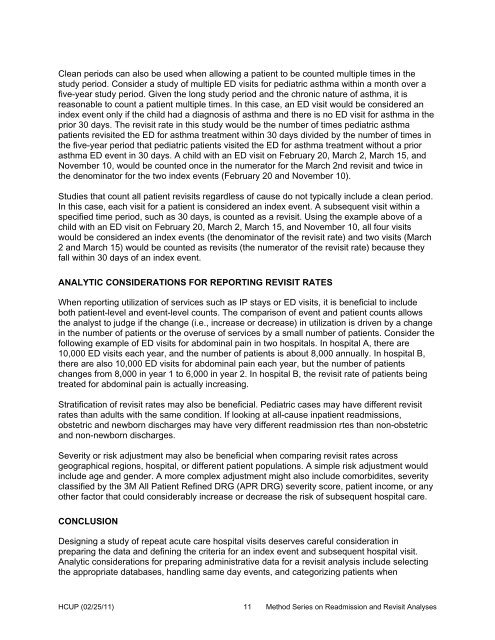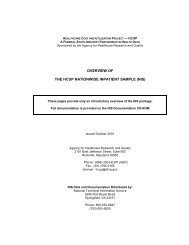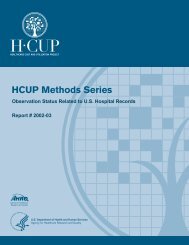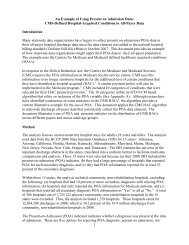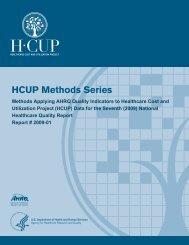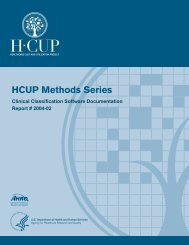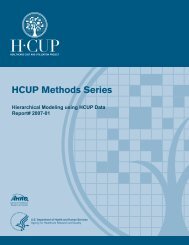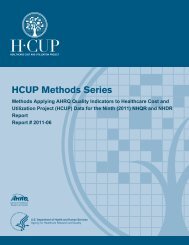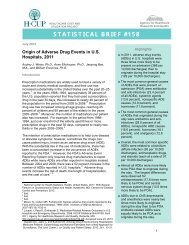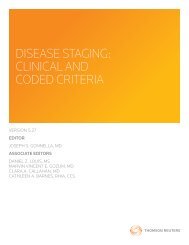Methodological Issues when Studying Readmissions and ... - HCUP
Methodological Issues when Studying Readmissions and ... - HCUP
Methodological Issues when Studying Readmissions and ... - HCUP
Create successful ePaper yourself
Turn your PDF publications into a flip-book with our unique Google optimized e-Paper software.
Clean periods can also be used <strong>when</strong> allowing a patient to be counted multiple times in thestudy period. Consider a study of multiple ED visits for pediatric asthma within a month over afive-year study period. Given the long study period <strong>and</strong> the chronic nature of asthma, it isreasonable to count a patient multiple times. In this case, an ED visit would be considered anindex event only if the child had a diagnosis of asthma <strong>and</strong> there is no ED visit for asthma in theprior 30 days. The revisit rate in this study would be the number of times pediatric asthmapatients revisited the ED for asthma treatment within 30 days divided by the number of times inthe five-year period that pediatric patients visited the ED for asthma treatment without a priorasthma ED event in 30 days. A child with an ED visit on February 20, March 2, March 15, <strong>and</strong>November 10, would be counted once in the numerator for the March 2nd revisit <strong>and</strong> twice inthe denominator for the two index events (February 20 <strong>and</strong> November 10).Studies that count all patient revisits regardless of cause do not typically include a clean period.In this case, each visit for a patient is considered an index event. A subsequent visit within aspecified time period, such as 30 days, is counted as a revisit. Using the example above of achild with an ED visit on February 20, March 2, March 15, <strong>and</strong> November 10, all four visitswould be considered an index events (the denominator of the revisit rate) <strong>and</strong> two visits (March2 <strong>and</strong> March 15) would be counted as revisits (the numerator of the revisit rate) because theyfall within 30 days of an index event.ANALYTIC CONSIDERATIONS FOR REPORTING REVISIT RATESWhen reporting utilization of services such as IP stays or ED visits, it is beneficial to includeboth patient-level <strong>and</strong> event-level counts. The comparison of event <strong>and</strong> patient counts allowsthe analyst to judge if the change (i.e., increase or decrease) in utilization is driven by a changein the number of patients or the overuse of services by a small number of patients. Consider thefollowing example of ED visits for abdominal pain in two hospitals. In hospital A, there are10,000 ED visits each year, <strong>and</strong> the number of patients is about 8,000 annually. In hospital B,there are also 10,000 ED visits for abdominal pain each year, but the number of patientschanges from 8,000 in year 1 to 6,000 in year 2. In hospital B, the revisit rate of patients beingtreated for abdominal pain is actually increasing.Stratification of revisit rates may also be beneficial. Pediatric cases may have different revisitrates than adults with the same condition. If looking at all-cause inpatient readmissions,obstetric <strong>and</strong> newborn discharges may have very different readmission rtes than non-obstetric<strong>and</strong> non-newborn discharges.Severity or risk adjustment may also be beneficial <strong>when</strong> comparing revisit rates acrossgeographical regions, hospital, or different patient populations. A simple risk adjustment wouldinclude age <strong>and</strong> gender. A more complex adjustment might also include comorbidites, severityclassified by the 3M All Patient Refined DRG (APR DRG) severity score, patient income, or anyother factor that could considerably increase or decrease the risk of subsequent hospital care.CONCLUSIONDesigning a study of repeat acute care hospital visits deserves careful consideration inpreparing the data <strong>and</strong> defining the criteria for an index event <strong>and</strong> subsequent hospital visit.Analytic considerations for preparing administrative data for a revisit analysis include selectingthe appropriate databases, h<strong>and</strong>ling same day events, <strong>and</strong> categorizing patients <strong>when</strong><strong>HCUP</strong> (02/25/11)11Method Series on Readmission <strong>and</strong> Revisit Analyses


